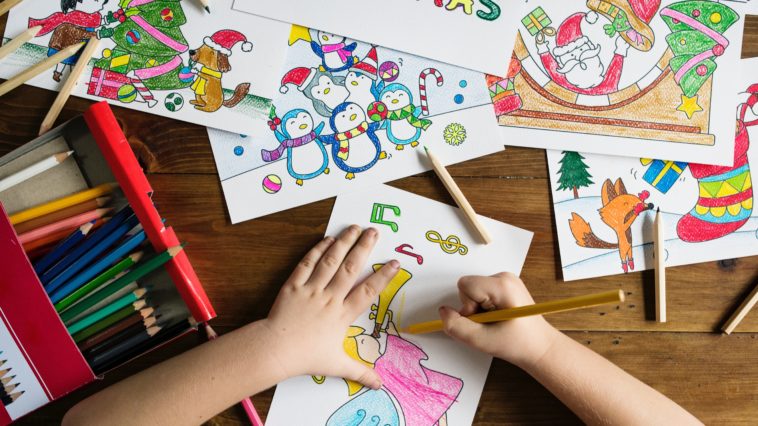Toddlers are learning about their world at a rapid pace. They are refining their sensory awareness so that they can interpret and anticipate what their senses are telling them, and increasing their motor skills so that they can use their bodies to achieve desired goals.
Both these skills require the ability to pay attention to what is happening around them and what is happening inside them. The games in this part of the book are designed to give children experience in these areas so that they can expand their ability to be attentive to everything going on around and within them
1 Bracelet of Leaves
You can encourage your little one to notice the many shapes of leaves by making a masking tape leaf bracelet. It will give a focus to your child’s outdoor time and increase his ability to scan and explore.
TYPES OF ATTENTION ENCOURAGED
- Open and focused
MATERIALS
- Masking tape
- Leaves
DIRECTIONS
Wrap a piece of masking tape around your child’s wrist, sticky side up, and then go exploring to find wonderful leaves and other interesting things to attach to the bracelet.
Before bedtime, snip the bracelet off and attach it next to his bed or somewhere in view so he can have a visual reminder of that fun experience.
VARIATIONS
• Make a flower bracelet. Collect little wildflowers.
• Wrap tape around the sleeves of your child’s coat so that larger leaves or flowers can be included.
WHAT’S BEING LEARNED
Children are scanning the environment to find the leaves needed to enhance their bracelet. Then, with help, they are noticing the different details of the various leaves, such as color patterns, shape, and vein configuration. “Look how this leaf is shaped like a heart and this one looks more like an arrow.”
This game will help make them generally more attentive to their environment on other days.
2The Enchantment of Water
Although the “equipment” may seem too simple, a sponge and a bowl of water can provide some interesting focusing times for your toddler. (CAUTION: never leave a child alone near even very shallow water.)
TYPE OF ATTENTION ENCOURAGED
- Focused
MATERIALS
- Large dish pan or bowl
- Clean, dry sponges
DIRECTIONS
Cut the sponges into pieces that your child’s hand can easily squeeze but that are too big to swallow.
In a place you don’t mind getting wet, have your child sit in front of a large dish pan. Put a shallow amount of water in the pan and toss in the sponges. Let your child have the fun of seeing the sponges float when dry and then noticing what happens as they get wet. Show your child how to soak up the water with the sponge and then squeeze it out.
VARIATIONS
• Cut a plastic bottle in half so that the top half is a funnel and the bottom is a cup. Tape the edges with duct tape to cover up any sharp edges. Make the cup more interesting by punching holes in the sides so that when it’s full, water sprinkles out of the sides. Show your child how to squeeze water from the sponge into the funnel or the cup and watch what happens to the water.
• Put a tennis ball in the water so that your child can chase it around with her hand as it moves freely in the dish pan
.• Add corks to the water and teach your little one to blow through a straw and make the corks move about.
• Add large chunks of ice by freezing water inside an empty milk carton. Add food coloring and even small toys to the water before freezing, if you want.
• These same games can be played in the bath or a toddler pool.
WHAT’S BEING LEARNED
Children are getting their first lesson in the magic of things changing properties when they get wet. In this case, they are observing something that floats when it’s dry and sinks when it’s wet.
Children also have the opportunity to be captivated by the behavior of water, such as how it can pour through and out of different types of containers.
These are experiences that will absorb children’s interest and show them that there are fascinating things in their world to explore.
3 Follow the Floating Feather
As mesmerizing as watching dancing dust motes, following the trajectory of a feather is both compelling and calming.
My friend Jenny discovered this game when dropping a feather for her son to watch. He was so fascinated by the feather’s moving with the air currents as it gently floated down that he wanted to keep repeating the game.
I’ve even used the fascination with feather movements with a group of older children. They were wild and winding down from playing a series of lively movement games. I could feel that the teacher was a little worried about the high energy. I ended the session by standing them in a circle and having them gently blow a feather from one person to the next. Peace and calm prevailed.
TYPE OF ATTENTION ENCOURAGED
- Focused
MATERIALS
One or more feathers. (A single feather will do, but you can buy a whole bag of multicolored feathers at a craft store.)
DIRECTIONS
Drop the feather and encourage your child to watch it as it slowly drops. To help him keep his eye on the feather’s movement, suggest that he catch it as it falls.
Drop the feather from different heights or in different places in the room or outside to help him notice how movement is affected by air currents.
VARIATION
Blow the feather to your child and ask him to blow it back to you.
WHAT’S BEING LEARNED
In addition to increasing children’s focusing skills, watching the movement of the feather enhances the control, strength, and flexibility of their eye muscles.
By noticing the differences in how the feather behaves in different air currents, children are becoming aware of the subtle effects of air movement. You can enlarge on this awareness by pointing out the different directions that leave flutter and flower stalks bend when affected by the wind.




